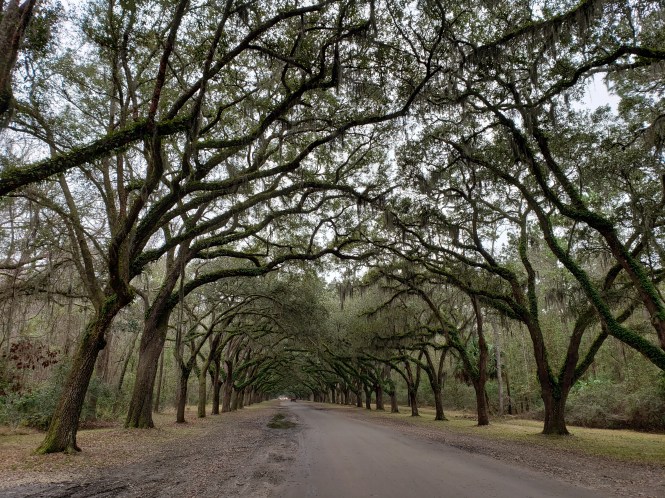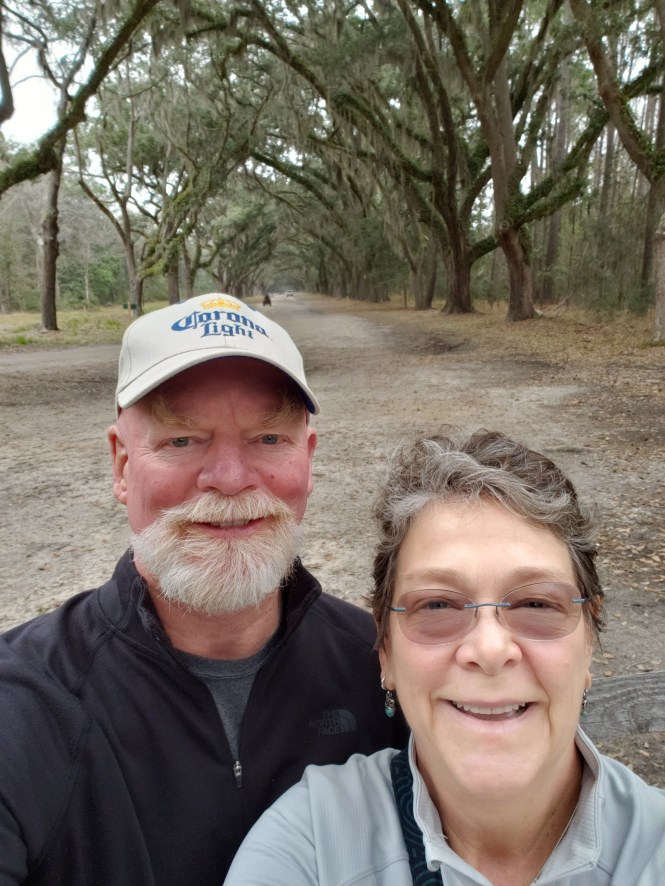On the Isle of Hope, about 8 miles south of Savannah, we explored a Georgia State Park historic site that is well worth a visit.
Despite the gloomy weather, we enjoyed the history and scenery in this low country treasure.

Wormsloe was established in 1736 by British colonist Noble Jones, a carpenter, surveyor, and physician. Talk about a Jack of all trades! He played important roles in the budding colony, both as a private citizen and public figure, including Commander of Georgia’s Northern Company of Marines, tithingman, constable, surveyor, Indian Agent, Treasurer of the Colony, Royal Councilor, and Justice of the Province.
Around 1893, Noble’s great-grandson Wymberley Jones De Renne planted 400 Live Oaks that majestically line Wormsloe’s 1.5-mile entrance. This drive alone is worth the entry fee!

After marveling over the incredible trees, we visited the small museum, full of family and area history, plus artifacts from the site over 300 years.
Then we embarked on the mile-long walking tour, which covers tabby ruins, an ancient shell midden, colonial living sites, and Noble’s gravesite.

Those trees! 😍
In 1737, Noble began construction on a fortified tabby house overlooking the major water route of the time in Savannah. Construction was disrupted multiple times by skirmishes with the Spanish, and the home was completed by 1745. The ruins are now the oldest standing structures in the Savannah area.






Construction of the home took 6 years and required mixing of more than 8,000 bushels each of lime, sand, oyster shells, and water to make the tabby. Amazing that parts of the structure remain today almost 300 years later!
Noble’s descendants rarely visited the property until around 1828, when grandson George Jones began construction of a two-story frame house about a half-mile north of the abandoned tabby house. Seven generations of descendants have made the house their home up to the present day, and that portion of the property is private.
Beyond the ruins, the remains of an ancient shell midden, or pile of oyster shells, can be found on the edge of the marsh. This midden was the source of the bulk of the oyster shells that made up the tabby house.

A stone monument and iron fence mark the site of Noble Jones original burial site.

Noble, his wife Sarah, and youngest son Inigo were buried here, but later their remains were moved twice; first to Colonial Cemetery in downtown Savannah, and later to the famed Bonaventure Cemetery.
From the burial site, we followed the trail to a small colonial life area, featuring a wattle and daub hut and corral, like those quarters used by Jones’ marines, indentured servants, and probably slaves. In addition to the one-room hut with sleeping loft and chimney, there are primitive covered shelters used for blacksmithing and other vital village functions.

There is much more to be discovered about this founding family of the Georgia colony, but I will leave that for you to discover should you visit.

One last view of the oaks as we depart


On the road?
LikeLiked by 1 person
Yes sir! We sold the house on Feb 20, went to Savannah for a few days, now in Brunswick, GA, then to St Augustine Thursday for a wedding and to establish residency. We head to Texas and points west mid-March! Yay, really enjoying being footloose and fancy free! 😎
LikeLike
Congratulations!
LikeLiked by 1 person
Thank you!
LikeLike
Gorgeous!
LikeLike
Thank you, Cindy! ❣
LikeLike
Woo-hoo!! We are almost there. Have a few things left in the house to sell. and then the house. What a great piece of history and great pix as always. I love history.
LikeLiked by 1 person
Thanks for the kind words, and I am wishing you success in your selling and hitting the road! 😊
LikeLike
As always, i marvei at your narrative and hope the places we visit come with as many descriptivr words.
LikeLiked by 1 person
Dear Dan, you made us both laugh out loud! Thank you for your very kind descriptive words, and I am certain that all the places you visit will generate the appropriate words as well! 😍😘❤
LikeLike
Sold the house? You two really are footloose and fancy free! Congrats.
That oak lined lane/driveway is gorgeous. I agree that would be worth the price of admissions in itself. Thank you for the history lesson.
LikeLiked by 1 person
We are so excited to finally be true nomads, Brandy! 😍 Thank you for visiting and commenting! We will keep in touch as we work our way west to Oregon. We will be at Bonneville lock & dam Aug 1st, and are talking with the folks at Cape Disappointment about possibly being there over the winter too! 😀 What do you think? Are we crazy?
LikeLike
These pics are haunting, mesmerizing and unforgettable.
Exceedingly-well done!
LikeLiked by 1 person
You are too kind, sir!
LikeLike
[…] at the end of February while we were visiting Savannah, we followed up our morning visit to Historic Wormsloe plantation with a trek out to Fort Pulaski National Monument, on US 80 between Savannah and Tybee Island. […]
LikeLike
Hola! I thought of you this past weekend while visiting my friend, Heather, in Carolina Beach, NC. It was a beautiful day on Friday, so we took their boat up the intracoastal waterway to Masonboro Island, the “wild” island I thought for sure would have been decimated by the hurricane last September, but wasn’t. I still can’t believe how little damage that area suffered when the eye of the hurricane actually came ashore mere miles from Masonboro at Wrightsville Beach. Anyway… we found a chunk of tabby on the beach. I told her about this post and your fabulous pics, so I decided to re-visit this post and share the link. Thanks for blazing new trails and sharing details about your journey so beautifully.
LikeLiked by 1 person
Kathy, you are so kind, and I’m so happy you thought of me and this post! Tabby is such a fascinating substance, and just shows the gumption the settlers had to survive in such wild conditions. I can tell from your posts how much you love it there. 😍
LikeLike